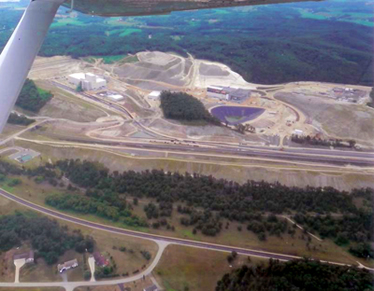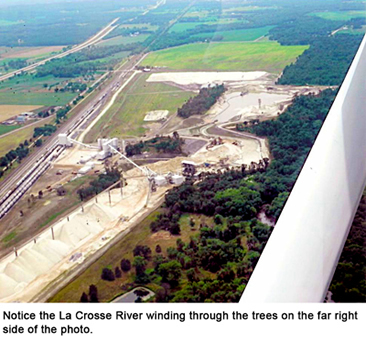Ecospirituality- Silica sand mining pandemic: our local contribution

by Carolyn Klein, affiliate
Frac sand mining is an environmental disaster of epic proportion taking place in the area surrounding La Crosse, Wis. Our unique Driftless Region is known for its very rare geological formations, underground rivers, caverns, unique plant life and much more. So beautiful in fact, a documentary, Mysteries of the Driftless, was produced by the Mississippi Valley Conservancy and Untamed Science and premiered in 2013.
One gift of being untouched by glacier is the thick layered bed of rare silica sand found within tree-covered bluffs that demark this Driftless Region. This silica sand, with its barb-like surfaces, is ideal for holding open the fractures made in the shale beds where fracking for natural gas is occurring across the United States. After crews drill deep into earth’s bedrock, a watery mix of toxic chemicals and sand is forced down the well hole to embed itself and keep open the small fractures made by an underground explosion. Small pockets are tapped for oil and gas that can then be brought to the surface for human consumption. Other types of sand, found elsewhere, are smooth and do not work well in this process.
 Here, we visit two sand mines located in the Driftless Region.
Here, we visit two sand mines located in the Driftless Region.
Tunnel City, Wis. (45 miles east of La Crosse)
Floodlights allow the mine to operate 24 hours a day, seven days a week, and many residents wonder about the long-term consequences of the wells drawing 2,350 gallons of water per minute (l.9 million gallons per day).
Sparta, Wis. (35 miles east of La Crosse)
Sparta’s silica sand mine sits on 325 acres of designated agricultural land that has been annexed into the city limits to open the way for the mining industrial operation. The mine is located on the far southwest edge of town and the prevailing winds that blow through town carry a load of microscopic silica sand particles with it.
 Different than many other operations, Sparta’s silica sand mining operation is a wet mining processing plant. It uses a vacuum-tube method to harvest the sand which is then pumped to the on-site processing plant for sorting and stockpiling—using thousands of gallons of water. This mine has drilled wells to tap into the ground water and artesian wells of the area to secure needed water to flood places where topsoil has been removed to form a lake for this method of wet mining. Eventually, the entire 325 acres will be nothing but one big shallow lake.
Different than many other operations, Sparta’s silica sand mining operation is a wet mining processing plant. It uses a vacuum-tube method to harvest the sand which is then pumped to the on-site processing plant for sorting and stockpiling—using thousands of gallons of water. This mine has drilled wells to tap into the ground water and artesian wells of the area to secure needed water to flood places where topsoil has been removed to form a lake for this method of wet mining. Eventually, the entire 325 acres will be nothing but one big shallow lake.
What can we do?
As Alexander Pope said in his 1733 essay on man, “Hope springs eternal!” While one individual can’t stop all the sand mining, we can find hope, support and encouragement in local grassroots organizations formed to address this pandemic. What a blessing to see the flow of networked contacts developing across local, state and national levels. It is paramount that each of us becomes educated and reveals the truth about silica sand mining as well as fracking for natural gas. Like mountaintop removal for coal, sand mining areas can never be fully reclaimed. Clean air and water will always be required for life.
For more information on sand mining in western Wisconsin check out Jim Tittle’s documentary, The Price of
Sand, available from Green Planet Film. It describes the environmental concerns and economic impacts of sand mining.


